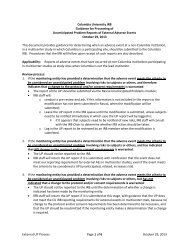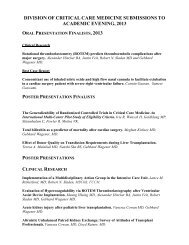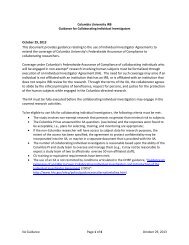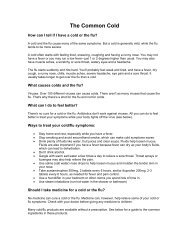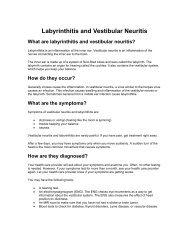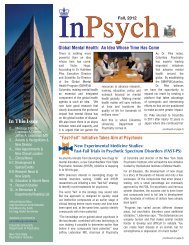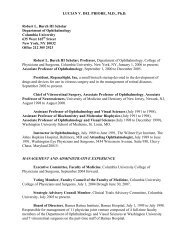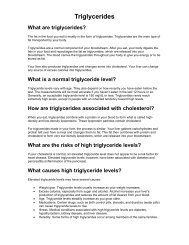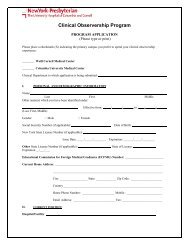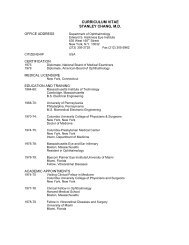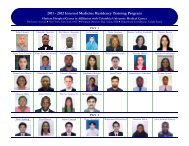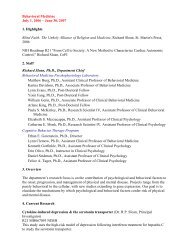news PS - Columbia University Medical Center
news PS - Columbia University Medical Center
news PS - Columbia University Medical Center
You also want an ePaper? Increase the reach of your titles
YUMPU automatically turns print PDFs into web optimized ePapers that Google loves.
is certainly specialty-oriented, as evidenced by<br />
the number of weeks devoted to surgical subspecialties:<br />
significantly more than in the curricula<br />
at the three medical schools where I have<br />
taught since graduation, all of which specifically<br />
require a family medicine rotation in the major<br />
clinical year with a separate clinical experience<br />
in outpatient primary care internal medicine.<br />
Whatever changes are made in our health care<br />
system, a greater focus on training clinicians for<br />
the primary care setting will be necessary. While<br />
<strong>Columbia</strong> should not move away from providing<br />
such excellent training in specialty care, I am<br />
delighted that medical students are having more<br />
exposure to the residents and faculty in family<br />
medicine. Throughout my clinical rotations, I<br />
enjoyed engaging with P&S faculty about what<br />
they considered most important for referring<br />
primary care physicians to know about their<br />
fields, and this approach has served me well in<br />
my career so far. I believe it works the other way,<br />
as well, in that specialists in training will benefit<br />
greatly from learning the perspective of referring<br />
physicians. I look forward to seeing the increasing<br />
impact of family medicine on P&S students<br />
reflected in match lists in the years to come.<br />
Clara (Holt) Keegan’02<br />
Burlington, Vt.<br />
Loeb and Other Legends<br />
Congratulations on the Autumn 2011 issue which<br />
has just arrived. Herewith a few comments.<br />
The argument over Robert Loeb will go on<br />
as long as he remains in memory – the sign of<br />
a giant. I arrived at P&S in 1949 as the first<br />
ever Fellow in rheumatology. I was assigned to<br />
the late great Charles Ragan and was treated<br />
as a regular faculty member. Loeb and Atchley,<br />
even then, were legendary but Loeb went out<br />
of his way to be caring, courteous, and almost<br />
friendly to me. At times I was even his sounding<br />
board when he wanted to voice his frustration<br />
at things that did not achieve his level of<br />
perfection. The chief resident in medicine was<br />
the late Calvin Plimpton, who later became<br />
president of the American <strong>University</strong> of Beirut,<br />
then Amherst and finally Downstate. Cal and<br />
I, in 1951, were granted the degree of Doctor<br />
of <strong>Medical</strong> Science (I don’t know if that degree<br />
is still granted). I defended my thesis before a<br />
challenging group which included Loeb and he<br />
was incisive but fair and – most importantly –<br />
he voted to grant me the degree! It was based<br />
on the research done during my tenure under<br />
Ragan, research which would later lead to my<br />
development of the latex fixation test which<br />
helped establish both rheumatology and immunology<br />
as full-fledged disciplines.<br />
I continue to follow P&S <strong>news</strong> with great<br />
interest. My wife and I flew to San Francisco<br />
to be with our dear friend Eph Engleman on his<br />
100th birthday. We were saddened by the recent<br />
death of Barry Blumberg, who succeeded me as<br />
a rheumatology Fellow at P&S but made his<br />
mark as the discoverer of the hepatitis B virus.<br />
The current and estimable dean, Lee Goldman,<br />
paid me a visit several months ago when<br />
I had a new aortic valve inserted at <strong>Columbia</strong>-<br />
Presbyterian [now NewYork-Presbyterian Hospital].<br />
This has helped me to recently reach my<br />
90th birthday and I have my eyes set on the<br />
Engleman mark!<br />
Keep up the good work.<br />
Charles M. Plotz, M.D., Med.Sc.D.’51<br />
By email<br />
M.D.s, not <strong>Medical</strong> Providers<br />
Upon graduation from medical school, we<br />
were awarded diplomas which noted that we<br />
were Doctors of Medicine. In recent times, we<br />
are noted to be “medical providers,” which<br />
seems to delete us from our rightful designation<br />
of M.D. Am I the only one who regrets this<br />
as a put down? Are we now in the same league<br />
as nurses (RNs) or members of emergency medical<br />
technicians (EMTs)? How can our local or<br />
state medical societies, the AMA, the ACS, or<br />
other large medical societies ignore this, and not<br />
try to get our proper identity back? Should the<br />
medical schools in the USA get involved in this<br />
situation? I am interested to read the responses<br />
to this letter to the editor.<br />
Stan Edelman’53<br />
By email<br />
“I Went to <strong>Medical</strong> School Because of Her”<br />
Thank you for the lovely words about Dr.<br />
Martha MacGuffie. I went to medical school<br />
because of “Bobby.” I had started out college<br />
premed but decided the courses were too diffi-<br />
cult. In the late 80s I met Bobby while working<br />
at AmeriCares and had the opportunity to travel<br />
to Kenya with her. Prior to meeting Bobby I had<br />
never met a woman doctor or any professional<br />
woman who was not a teacher or a secretary.<br />
Bobby was down to earth, funny, warm and<br />
told larger than life stories about her adventures<br />
in medicine and as a mother; she had eight children.<br />
I reasoned if Bobby could go to medical<br />
school and have eight children I could probably<br />
do it too. It was that simple. I think the thing I<br />
remember most about Bobby was her hands:<br />
She had the hands of an artist, large, knobby,<br />
always moving while she talked. She liked to<br />
compare her work as a plastic surgeon to being<br />
a sculptor. I feel so fortunate that she touched<br />
my life. She was opening doors for others her<br />
whole life.<br />
P.S. Thanks for the piece on family medicine<br />
in the same issue!<br />
Melissa Bradner’96<br />
Richmond, Va.<br />
Metabolic Surgery<br />
It sounds like <strong>Columbia</strong> is still doing a discredited<br />
operation that produces results for two<br />
years (Clinical Advances, Fall 2011 issue). It<br />
is antique. <strong>Columbia</strong> should start the duodenal<br />
switch (controlled malabsorbtion) which<br />
Ara Kishishian, M.D. (formerly my landlord),<br />
brought here from Detroit 15 years ago. I see<br />
some of his patients for urology. The cure of<br />
diabetes is permanent as is the cure of hypertension.<br />
They are svelt new people and the fat does<br />
not come back.<br />
Anthony H. Horan’65<br />
Delano, Calif.<br />
Editor’s Note: More about metabolic surgery can<br />
be found in this issue, Page 24.<br />
send letters to:<br />
Bonita Eaton Enochs, Editor<br />
<strong>Columbia</strong> Medicine<br />
College of Physicians & Surgeons<br />
630 W. 168th St., P&S Box 27<br />
New York, NY 10032<br />
E-mail: columbiamedicine@columbia.edu<br />
Spring 2012 <strong>Columbia</strong>Medicine 3



